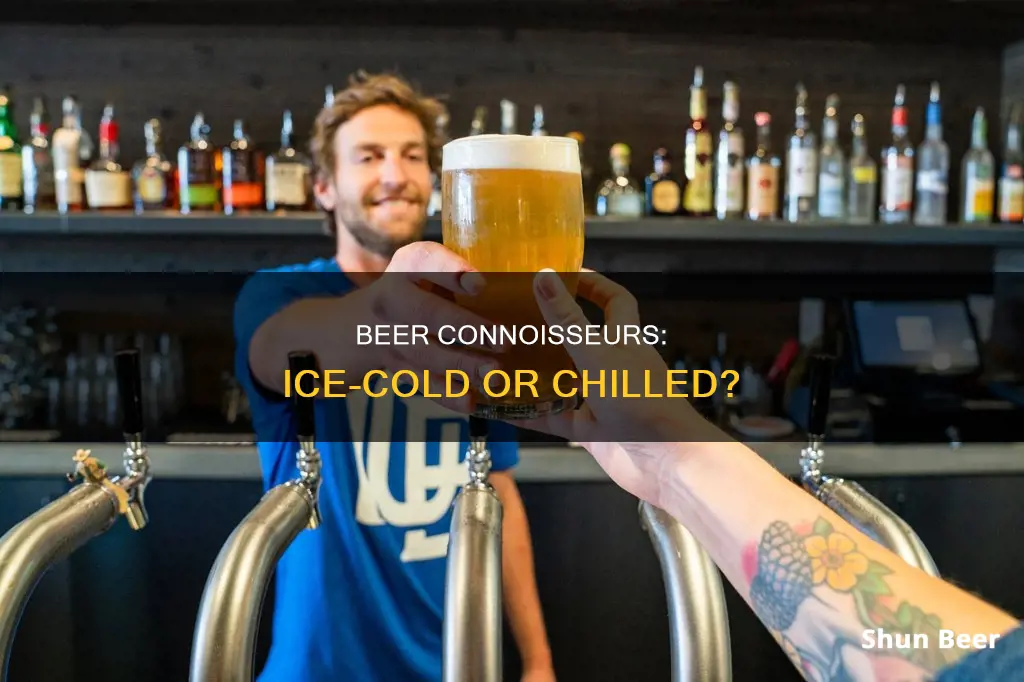
There's nothing quite like a cold beer on a hot summer day, but is ice-cold the best temperature to serve a beer? It depends on the type of beer and your personal preference. For mass-produced lagers, ice-cold is just fine, but for craft beers with more complex flavours and nuances, serving them ice-cold can mute the taste and make it harder to detect the full range of flavours and aromas.
| Characteristics | Values |
|---|---|
| Ideal serving temperature for beer | 45-55°F (7-12°C) |
| Beer served too cold | Harder to taste or smell the full range of flavors |
| Beer served too warm | Less enjoyable to drink |
| Beer with ice | Dilutes the flavor, alters carbonation, causes excessive foaming, less visually appealing |
| Mass-produced lagers served ice-cold | Fine |
| Craft beers served ice-cold | Lose their distinct styles, flavor profiles, and nuances |
What You'll Learn

Ice-cold beer is fine for mass-produced lagers
Ice-cold beer is perfectly acceptable for mass-produced lagers. In fact, it's the preferred way to drink them. This includes the light lagers with "lite" in the name, which are best served at temperatures of 35–40°F (2–4°C).
Ice-cold beer is so popular that it's become a staple in American popular culture, with references in songs by artists ranging from Pink to the Grateful Dead, and it's a common lyrical theme in country music.
When it comes to mass-produced lagers, ice-cold temperatures can mask the lack of complexity in their flavour profiles. These beers are often chosen for their refreshing qualities, especially on hot days, rather than for their taste.
However, it's important to note that serving any beer at extremely low temperatures can make it harder to taste and smell its full range of flavours. This is because colder temperatures cause carbon dioxide to become more soluble, leading to less fizz and a duller flavour experience.
Beer and Kidney Infections: A Risky Combination?
You may want to see also

Craft beers are best served warmer to appreciate their complex flavours
While ice-cold beers are often associated with summertime backyard barbecues and sports events, serving craft beers ice-cold may not be the best way to appreciate their complex flavours.
Firstly, it's important to understand how serving temperature affects the taste of beer. Chilling a beer below its ideal serving temperature can enhance certain qualities while masking others. Ice-cold temperatures can slow the volatilisation of aromatic compounds, causing them to linger in the beer. This can alter the flavour and aroma, sometimes making the beer taste thin and almost tasteless. The cold can also enhance bitterness, dryness, and carbonation, which may result in an unpleasant drinking experience if paired with a thin, tasteless beer.
On the other hand, serving craft beers at warmer temperatures allows more of the flavours and aromas to come to the forefront. Warmer temperatures can activate and enhance the myriad chemical compounds responsible for the aromas and flavours in craft beers. For example, increasing the temperature strengthens the electrical signals that tell the brain what you're tasting. This is why a somewhat warmer stout expresses a balance between malt sweetness and roast bitterness, while an ice-cold stout may taste harshly bitter.
Additionally, serving craft beers warmer can encourage a more subdued sipping pace, allowing you to savour the complex flavours. The foam on a warmer beer also tends to be tighter and longer-lasting, ensuring that the aroma continues to last as the tiny bubbles at the top of the glass continuously pop.
When it comes to specific styles of craft beer, different temperature ranges are recommended to optimise their flavour profiles. For instance, IPAs, American pale ales, porters, and most stouts are best served between 45–50°F (7–10°C). Belgian ales, sour ales, Bocks, English bitters, and milds are suggested to be served at a slightly warmer temperature of 50–55°F (10–13°C). For barley wines, imperial stouts, Belgian strong ales, and Doppelbocks, a temperature range of 55–60°F (13–16°C) is recommended.
In conclusion, while personal preference always comes first when it comes to drinking beer, serving craft beers slightly warmer can unlock their complex flavours and enhance the drinking experience. So, the next time you pour yourself a craft beer, consider letting it warm up just a bit to discover the nuances that make it so special.
Beer and Invisalign: What You Should Know
You may want to see also

Ice in beer dilutes the flavour and alters carbonation
Beer is a popular beverage worldwide, and opinions differ on how it should be served. While some people prefer their beer chilled straight from the fridge, others opt for ice-cold beer. The preference for ice-cold beer is more common in warmer climates, where the ice helps keep the beer cold for longer. However, adding ice to beer can dilute its flavour and alter its carbonation, resulting in a less enjoyable drinking experience.
Beer enthusiasts believe that adding ice can interfere with the intended flavour and texture of the beer. When ice is added to a beer, it melts over time, watering down the beverage. This dilution can disrupt the balance of carefully crafted ingredients, making the beer taste bland or weak. This effect is more pronounced in beers with nuanced flavours, such as stouts, IPAs, and other richly flavoured brews. The dilution not only affects the taste but also reduces the alcohol content, which can be disappointing for drinkers who expect a fuller experience from their craft beer or full-bodied ale.
The carbonation level of a beer also plays a crucial role in its overall quality. Carbonation is the presence of carbon dioxide gas in a liquid, which gives beer its distinctive fizz and contributes to its mouthfeel. Proper carbonation ensures a refreshing aspect to the beer. However, when ice is added to a beer, it can alter the carbonation process. As the ice melts, it introduces additional water into the beer, which can affect the carbonation levels. This disruption in carbonation can impact the beer's mouthfeel and overall drinking experience.
Furthermore, serving temperature has a significant impact on the taste of beer. While colder temperatures might seem like a safer option, they can hinder the flavour profile of certain beers. When served ice-cold, some beers can seem mediocre or underwhelming. Allowing the beer to warm up slightly can unlock its intended flavours and enhance the drinking experience. This is particularly true for English ales, where serving them warmer can bring out their true character. Thus, it is essential to consider the optimal serving temperature for different beer styles to fully appreciate their unique characteristics.
In summary, while adding ice to beer might be tempting to keep it cold, it can negatively impact the flavour, carbonation, and overall quality of the beverage. Beer enthusiasts recommend enjoying the beer as intended by the brewer—chilled but without ice—especially when dealing with complex and nuanced craft beers. By respecting the intended serving temperature, drinkers can fully appreciate the balance of flavours and carbonation that the brewer has carefully crafted.
Beer and Prozac: What You Need to Know
You may want to see also

Ice-cold beer dulls your taste buds and suppresses flavour
While many people enjoy a beer served ice-cold, this temperature can actually dull your taste buds and suppress the flavour of the drink.
Temperature has a significant effect on our taste buds. The chemical compounds responsible for the various aromas and flavours in beer are activated and suppressed differently according to temperature. Warmth usually makes a flavour more perceptible, while cold temperatures tend to suppress it. A study by researchers at the Chinese Academy of Sciences found that alcoholic beverages taste more or less "ethanol-like" at different temperatures. The temperature of the liquid changes how the water and ethanol form, creating either chain-like or pyramid-shaped clusters at the molecular level, which in turn impacts how the drink tastes. At low concentrations, the alcohol forms more pyramid-shaped structures around the water molecules, while at higher concentrations, the alcohol arranges itself in a chain.
This is why a beer served ice-cold may taste less flavourful than one served at a slightly warmer temperature. When a beer is ice-cold, the flavour compounds are less activated, resulting in a dulling of the taste buds and a suppression of flavour. This is particularly true for craft ales and lagers, including most homebrews. These beers often have complex flavours and aromas that are meant to be savoured and appreciated, and serving them ice-cold can mask their unique characteristics.
For example, an ice-cold stout may taste harshly bitter, while a slightly warmer sample may express a better balance between malt sweetness and roast bitterness. Similarly, IPAs, American pale ales, porters, and most stouts are typically enjoyed at temperatures between 45–50°F (7–10°C) to allow the full range of flavours to come through. On the other hand, mass-produced lagers are often consumed ice-cold as they are meant to provide refreshment rather than a complex tasting experience.
In summary, while some beers are best enjoyed ice-cold, this temperature can dull the taste buds and suppress the flavour of more complex craft beers. Allowing these beers to warm up slightly before drinking can enhance the tasting experience and allow the drinker to appreciate the full range of flavours and aromas that the brewer intended.
Beer and Braces: What You Need to Know
You may want to see also

The optimal temperature for most beers is 45-55°F (7-12°C)
While personal preference plays a role in how people enjoy their beer, the optimal temperature for most beers is 45–55°F (7–12°C). This temperature range allows drinkers to appreciate the beer's full range of aromas, flavours, and complexities.
At temperatures below this range, the beer's aroma molecules can become trapped, dulling the overall flavour experience. As Shana Solarte, an Advanced Cicerone and content manager for Cicerone, explains, "Serve beer too cold and you won't be able to taste everything." Natalya Watson, a beer sommelier and Advanced Cicerone, agrees, noting that cold liquid holds more carbon dioxide in solution than warm liquid, impacting the beer's aroma and flavour.
When beer is served too warm, the bubbles and aromas escape before the drinker can fully enjoy them. Additionally, warmer temperatures can make the beer less refreshing. Thus, the optimal temperature range of 45–55°F strikes a balance, allowing drinkers to experience the full flavour profile without sacrificing refreshment.
It's worth noting that the ideal temperature can vary slightly depending on the style of beer and personal preference. For example, mass-produced lagers are often enjoyed ice-cold, while craft beers with more complex flavours may be better appreciated at slightly warmer temperatures. However, as a general guideline, the 45–55°F range is ideal for maximising the enjoyment of most beers.
To ensure you're getting the most out of your beer, proper storage and serving practices are essential. This includes storing beers away from heat sources, pairing different styles of beer with optimal temperatures, and using properly chilled glassware.
Sam Adams' Drinking Habits: Beer or Not?
You may want to see also
Frequently asked questions
Drinking beer ice-cold is not recommended as it can diminish the flavour and aroma of the beverage.
When beer is ice-cold, it becomes hard for the drinker to taste or smell the full range of flavours and aromas in the glass.
The ideal temperature for drinking beer is between 45-55°F (7-12°C).
Mass-produced lagers are best served ice-cold.
Craft beers, including ales and lagers, should not be served ice-cold as it can mute their distinct flavour profiles and nuances.







